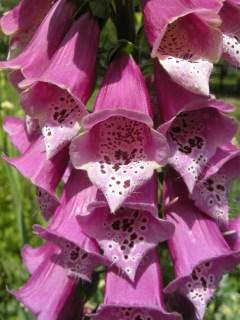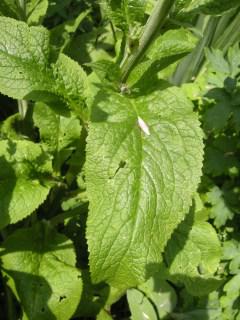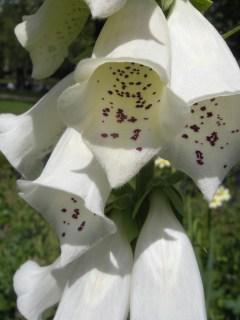
Digitalis purpurea Flower (30/05/2012, London)
Position: Full sun to partial shade
Flowering period: Early summer
Soil: Moist, well drained
Eventual Height: 2m
Eventual Spread: 50cm
Hardiness: 4a – 9a
Family: Plantaginaceae
Digitalis purpurea is an erect herbaceous biennial, producing vegetative growth in the first year and flowering in the second. Its mid green leaves are lanceolate with serrate margins, are covered in grey/ white hairs, are up to 30cm long and 12cm broad. They are spirally arranged, forming a tight rosette at ground level at first year. Its purple flowers are tubular, pendant up to 5cm long and arranged on a terminal, elongated cluster. Its fruit is a capsule which releases numerous small (0.2mm) seeds at maturity.

Digitalis purpurea (30/05/2012, London)
Digitalis purpurea, commonly known as Foxglove, Common Foxglove, Purple Foxglove,Fairy Glove or Lady’s Glove, is native to most of Europe. In its native habitat it grows in woodland glades, woodland margins, in grassland and in other areas where the ground is disturbed. All parts of this plant are potentially poisonous. It is listed as ‘weedy or invasive’ by the US Department of Agriculture.
The etymological root of the binomial name Digitalis is derived from the Latin digitus meaning ‘finger’, referring the shape of the flower. Purpurea is from the Latin meaning ‘purple’, referring to the flower.

Digitalis purpurea Leaf (30/05/2012, London)
The landscape architect may find Digitalis purpurea useful as part of a mixed herbaceous planting scheme, including prairie style planting schemes. Although it is a biennial and will die in its second year, it will readily self seed give the right conditions.
Ecologically, D. purpurea is attractive to bumblebees.It provides food for a number of moth species.
D. purpurea prefers moist, humus rich, well-drained soils. It tolerates most pH of soil. It will not tolerate wet soils.
Digitalis purpurea requires little maintenance. Excessive self seeded seedlings may be removed by hand.

Digitalis purpurea ‘Camelot Cream’ Flower (30/05/2012, London)

